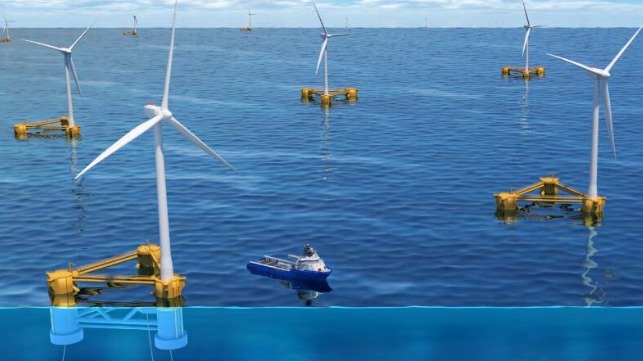U.S. Launches Efforts to Accelerate Floating Offshore Wind Deployment

The U.S. Government is launching a series of new initiatives and projects all designed to accelerate the deployment of floating offshore wind farms and to position the U.S. to lead the world in floating offshore wind technology. Recognizing that floating wind will play a critical component in the Biden administration’s goals, they conducted an inter-departmental summit during which a series of new programs were announced while also setting a goal to reduce the cost of floating offshore energy by more than 70 percent by 2035 and deploy 15 GW of floating wind also by 2035.
In announcing the new initiatives, the U.S. Department of Energy (DOE) says that two-thirds of America’s offshore wind resources will be located in deep-water areas that require floating platforms. Last year, the Bureau of Ocean Energy Management (BOEM) highlighted that floating wind was likely to be a key part of the sites it was auctioning located off California as the first-ever U.S. West Coast wind projects. Research has been ongoing in Maine with an initial demonstration project deploying a floating platform. The Maine project is expected to advance the research. The Department of the Interior is targeting additional West Coast lease auctions including the first off Oregon this year and expects the first commercial sites in the Gulf of Maine would be auctioned in 2024.
“Floating offshore wind offers untapped opportunities for us to produce clean, reliable, and affordable power for millions,” said U.S. Secretary of Energy Jennifer Granholm. “President Biden wants America to become a global leader of offshore wind technology and deployment, and with his historic climate investments, DOE is capturing this potential to spur private investment, boost the domestic supply chain, and deliver on our bold clean energy goals.”
The administration kicked off its efforts with the first-ever Floating Offshore Wind Shot Summit on February 22 and 23. It brought together the departments of Energy, Interior, Commerce, and Transportation along with key stakeholders to unite the agencies in the goal of driving progress.
One of the key focuses is on expanding the transmission capabilities to address constraints that currently limit offshore wind development along the West Coast. DOE is using some of the $100 million included in the 2022 Inflation reduction Act for transmission planning announcing a 20-month study, West Coast Offshore Wind Transmission. It will explore the steps required to harness offshore wind power into West Coast communities. DOE also presented an analysis that evaluates existing West Coast offshore wind energy transmission research.
As California will likely be the first location for floating wind platforms, it was announced that the state will join the National Offshore Wind Research and Development Consortium. DOE and others are funding the effort, and pending final approval, California will work with the consortium to fund R&D projects that respond to the critical, near-term offshore wind development priorities.
Looking longer-term, DOE and its Sandia National Laboratories and National Renewable Energy Laboratory are developing an industry-informed roadmap for new operations and maintenance technologies and processes to enhance the cost-effectiveness, efficiency, and reliability at offshore wind sites.
The new initiatives are in addition to government funding which is being used in the build-out of ports and infrastructure to support the growth of offshore wind development and the efforts to build the supply chain. In 2002, the government reports it invested $9.8 billion in the offshore wind industry more than three times the amount spent the year before.
